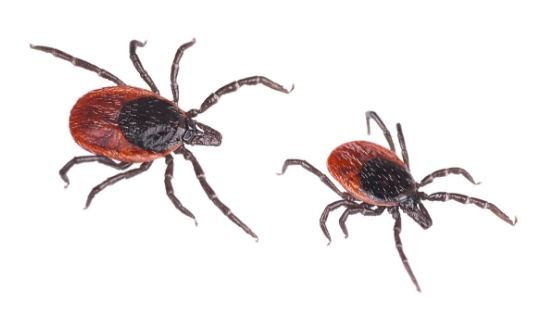Ticks in Car: Get Rid of & Prevent Them

Over 900 species of ticks are found throughout the world. While you may think of ticks as living in the woods, they can survive quite some time without food and could hitch a ride on you to get into your car. But, how long can ticks live in a car?
How Do Ticks Get Into Your Car?
Firstly, a tick may enter your car if they are on you and fall off into the car. Your dog could also be a transportation vessel for ticks. A tick could get on your dog and fall off in your vehicle.
How Long Can Ticks Live in a Car?
Keep in mind that a tick can go around a month without sucking blood and will still be able to survive. However, ticks that require high humidity, such as black-legged ticks, may only be able to survive for around 24 hours in your vehicle. On the other hand, if the tick species isn’t known to crave humidity, may be able to live a month or longer in your car.
How Do You Get Rid of Ticks in Your Car?
You should take a few steps to get rid of ticks in your car. For instance, park your car in the direct sunlight for a few hours. This is often enough to kill most creepy crawlies.
Make sure you clean up any damp areas or remove any damp items. For instance, if you have your gym bag or a beach towel, get rid of those. Certain breeds of ticks can’t survive without moisture.
Next, you could use an insect repellant specifically for ticks to get rid of them. Read the directions carefully and make sure the solution is safe for the interior of your car. You’ll also want to read the instructions and follow them closely to ensure the spray kills the ticks as it should.
How to Prevent Ticks from Getting in Your Car
Ideally, you should prevent ticks from getting in your car so you don’t have the hassle of trying to get rid of them. When you use your vehicle after going for a hike, hunting, or spending other time in the wooded area, be sure to check yourself for ticks before getting into your car. Keep in mind that ticks like warm, moist areas, such as in your armpits or hair.
When you find a tick, use a pair of fine-tipped tweezers to remove it. Use the tip of the tweezers to grasp onto the tick as close to your skin as possible. Keep a constant amount of pressure on the tick and pull the tweezers upwards. Don’t jerk or twist the tick. If you do, you could cause the tick to break off inside your skin, which can lead to the spread of disease if left there long enough.
Disinfected the site with rubbing alcohol. If you don’t have any, soap and water will work as well.
You should also check your dog for ticks before they get into the car.
Use a tick repellant on yourself. Make sure you use a tick prevention treatment for your dog regularly.
Are Ticks Dangerous?
One of the main concerns you may have with ticks getting into your car is whether these pests are dangerous. The answer depends on the type of tick you find. Only a few species are known to bite and transmit disease, as noted by the examples below.
American Dog Ticks
American dog ticks, also known as wood ticks, are brownish and known to transmit Rocky Mountain spotted fever — a disease that can be fatal if not treated early. Typically, the symptoms of Rocky Mountain spotted fever resemble the flu. Sometimes, it causes a rash, hence its name.
If you don’t get it treated with an antibiotic, the disease can damage your blood vessel’s lining or even your organs. Although rare, it can cause seizures or coma as well as lung or heart inflammation. These ticks can also cause tularemia, a bacterial infection that causes swollen lymph glands, skin ulcerations, diarrhea, and exhaustion, among other symptoms.
Black-legged Tick
The black-legged tick, also called deer ticks, may carry two different types of bacteria, Borrelia burgdorferi and B. mayonii, that cause Lyme disease. You may develop a fever, chills, headache, and other flu-like symptoms in the early stages. It’s estimated that between 20 and 80 percent of Lyme disease patients develop the erythema migrans (ER) rash, which resembles a bull’s eye.
When treated early, Lyme disease isn’t known to cause any serious problems. However, if you don’t receive treatment for Lyme, the infection can eventually damage your joints and certain organs, including your heart.
Other possible diseases the blacked-legged tick may cause include:
- Ehrlichia muris
- Anaplasmosis
- Ehrlichiosis
- Powassan virus
Lone Star Tick
Lone star ticks have reddish-brown bodies, and the females have a silver or white spot on their backs. These ticks are very aggressive when they bite humans. The lone star tick is known to carry a variety of diseases, including Bourbon disease, Heartland virus, tularemia, and southern tick-associated rash illness (STARI). Lone star ticks have been known to carry Lyme, but they don’t seem to transfer it to humans or pets.
Southern tick-associated rash illness may cause a rash similar to Lyme. This infection may cause muscle pain, fever, fatigue, and headache.
A common concern with the lone star tick is alpha-gal syndrome.
It’s not an infection. Instead, it’s an immune system response that occurs when the lone star tick transmits the alpha-gal sugar into an individual’s body. The person’s immune system reacts, and it may trigger the person to develop an allergy to red meat, including lamb, beef, or pork.
With both heartland and Bourbon disease, a person may experience fatigue, fever, headache, decreased appetite, and nausea. Heartland disease is from a virus, so there isn’t medication to treat it. In some cases, you may require hospitalization to manage your symptoms. Bourbon disease is also a viral infection. It’s a rather newer viral infection, and it can be deadly in some.
While ticks can live in your vehicle, not always for a prolonged period, you can take steps to prevent them from getting in your vehicle in the first place. If you should happen to have ticks in your car, you can use insecticides to rid your car of these nuisances.
Sources:
https://nysipm.cornell.edu/sites/nysipm.cornell.edu/files/shared/documents/tick-FAQ-list.pdf
https://www.cdc.gov/lyme/removal/index.htm



